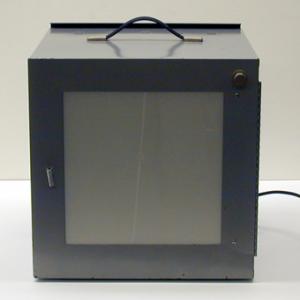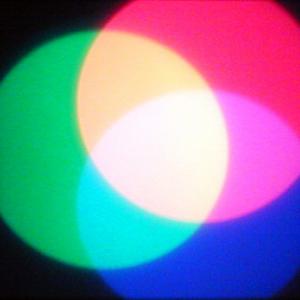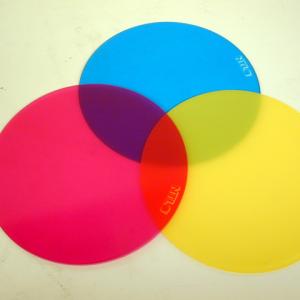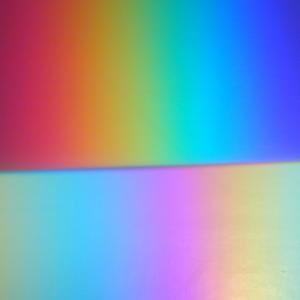College of Liberal Arts & Sciences
6F10.23 - Colors - Additive and Subtractive Primaries
Put the diffraction grating on the head of the overhead projector. When you put the special transparency plate on the overhead and turn it on you will have a spectrum of the primary colors on the top and the secondary colors directly underneath.
- Seungjin Kim, Jiwon Lee, "Subtractive Primary Color Separation with a Prism", TPT, Vol. 61, #6, Sept. 2023, p. 485.
- Paulo Simeão Carvalho and Marcelo Hahn, "A Single Experimental Setup for Teaching Additive Colors with Arduino", TPT, Vol. 54, #4, Apr. 2016, p. 244.
- Frances Ruiz and Michael J. Ruiz, "Color Addition and Subtraction Apps", TPT, Vol. 53, #7, Oct. 2015, p. 423.
- Adolf Cortel, "Simple Experiments on Perception of Color Using Cardboard Turbines", TPT, Vol. 42, #6, Sept. 2004, p. 377.
- Edward P. Wyrembeck, "A Student-Centered Interactive Color Quiz", TPT, Vol. 41, #9, Dec. 2003, p. 531.
- Burt Brody, "Yellow", TPT, Vol. 32, #4, Apr. 1994, p. 220.
- P.J. Ouseph, "A Prism Dispersion Apparatus", TPT, Vol. 25, #7, Oct. 1987, p. 459.
- R. D. Edge and Edwin R. Jones, Jr., "Demonstrating Additive Primary Colors", TPT, Vol. 22, #5, May 1984, p. 320.
- Maurice Bruce Stewart, "Letter - Shedding Light on Color", TPT, Vol. 21, #3, Mar. 1983, p. 144.
- Robert L. Lehrman, "Letter - Author Replies", TPT, Vol. 21, #3, Mar. 1983, p. 144.
- Dudley H. Towne, "Teaching Newton's Color Theory Firsthand", AJP, Vol. 61, #2, Feb. 1993, p. 113.
- Marvin Hoshino, "A Response to 'Dilemma of the Primary Colors'", AJP, Vol. 47, #7, July 1979, p. 573.
- R. D. Edge and R. Howard, "Dilemma of the Primary Colors", AJP, Vol. 47, #2, Feb. 1979, p. 142.
- Torger Holtsmark, "A Demonstration of Additive Color Mixing Rules Under the Influence of Color Contrast", AJP, Vol. 37, #6, June 1969, p. 662.
- O-730: "Theater Filters - Antifreeze", DICK and RAE Physics Demo Notebook.
- "Demonstration of Babinet's Principle", Apparatus Notes, July 1965 - December 1972, p. 110.
- "A Demonstration of Babinet's Principle Using Two-Dimensional Gratings", Apparatus Notes, July 1965 - December 1972, p. 111.
- Borislaw Bilash II and David Maiullo, "Are We Adding or Subtracting?", A Demo A Day: A Year of Physics Demonstrations, p. 318.
- Janice VanCleave, "53, Colored Sand", Teaching the Fun of Physics, p. 84.
- Christopher P. Jargodzki and Franklin Potter, "55, Primary Colors", Mad About Physics, p. 19, 169.
- Bobby Mercer, "What Color Is It?, Junk Drawer Physics, p. 100.
- Marsha M. Hobbs, "Using Holographic Diffraction Gratings for Lecture Demonstrations", PIRA News, Vol. 6, #5, Apr. 1992.
- T. D. Rossing, and C. J. Chiaverina, "Activity 4, Mixing Colors By Subtraction", Light Science, Physics and Visual Arts, p. 367.
- T. D. Rossing, and C. J. Chiaverina, "8.4, Transmission and Reflection Of Colored Light: Subtractive Color Mixing Revisited", Light Science, Physics and Visual Arts, p. 180.
- T. D. Rossing, and C. J. Chiaverina, "8.3, Additive Color Mixing (Revisited)", Light Science, Physics and Visual Arts, p. 178.
Disclaimer: These demonstrations are provided only for illustrative use by persons affiliated with The University of Iowa and only under the direction of a trained instructor or physicist. The University of Iowa is not responsible for demonstrations performed by those using their own equipment or who choose to use this reference material for their own purpose. The demonstrations included here are within the public domain and can be found in materials contained in libraries, bookstores, and through electronic sources. Performing all or any portion of any of these demonstrations, with or without revisions not depicted here entails inherent risks. These risks include, without limitation, bodily injury (and possibly death), including risks to health that may be temporary or permanent and that may exacerbate a pre-existing medical condition; and property loss or damage. Anyone performing any part of these demonstrations, even with revisions, knowingly and voluntarily assumes all risks associated with them.





